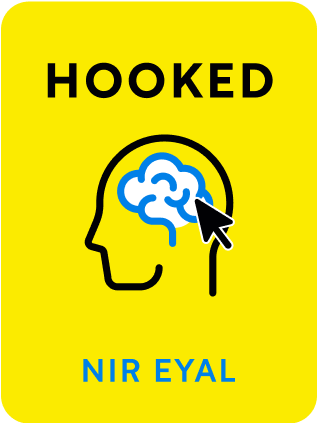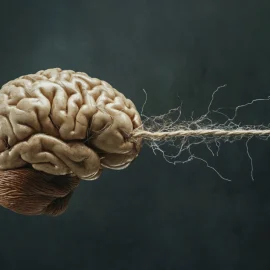

This article is an excerpt from the Shortform summary of "Hooked" by Nir Eyal and Ryan Hoover. Shortform has the world's best summaries of books you should be reading.
Like this article? Sign up for a free trial here .
What is Hooked by Nir Eyal about? How does Hooked by Nir Eyal explain habit-forming products?
Hooked by Nir Eyal is a book that explains the use of a 4-step loop to build habit-forming products. The steps and their requirements are discussed in more detail in Hooked by Nir Eyal.
Read more about the model at the heart of Hooked by Nir Eyal.
Habits in Hooked by Nir Eyal
Habits are a shortcut for your brain – you execute automatic behaviors without having to think hard about it. Habits develop when the behavior has solved the problem continuously in the past.
Habit-forming products use a 4-step loop to hook you:
- A trigger prompts the behavior.
- Triggers can be external or internal. External triggers come from outside a person’s thinking (e.g. phone notifications or seeing an advertisement). Internal triggers are internal drives (e.g. relieving boredom or loneliness).
- For products, behaviors often begin with external triggers. Then, as the habit forms, the behavior becomes associated with internal triggers.
- The trigger prompts an action, which is a behavior done in anticipation of a reward.
- An action is more likely when there is motivation to do it, and when it is easier to do.
- The action delivers a variable reward.
- Predictable rewards don’t cause cravings. You don’t crave turning on your faucet since you know what happens every time.
- In contrast, variable rewards prompt more intense dopamine hits and push the user to desire the next hit.
- In completing the action, the user invests in the product, improving her future experience and increasing the likelihood of completing another loop in the future.
- Investments include inviting friends, storing data, building a reputation, and learning to use features.
According to Hooked by Nir Eyal, each successive loop makes the next loop more likely to occur, causing a flywheel effect. To explain each in more detail:
Trigger
External triggers are delivered through the environment. They contain information on what the user should do next, like app notifications prompting users to return to see a photo.
Over time, as a product becomes associated with a thought, emotion, or preexisting routine, users return based on internal triggers. Emotions – especially negative ones like boredom, loneliness, confusion, lack of purpose, and indecisiveness – are powerful internal triggers. These triggers may be short and minor, possibly even subconscious.
To build a habit, you need to solve a user’s pain so that the user associates your product with relief.
To discover the root problem, the Nir Eyal book says you should ask “Why?” as many times as it takes to get to an emotion.
Action in Hooked by Nir Eyal
To initiate action in a habit, doing must be easier than thinking. An action has three requirements:
- Sufficient motivation
- Sufficient ability
- A trigger to activate the behavior
Make the process to use your product as simple as possible. Lay out the steps the customer takes to get the job done. Then remove steps until you reach the simplest possible process.
The Nir Eyal book says you need to identify which factor is most impeding your users. Is the mental effort needed to use your product too high? Is the user in a social context where the behavior is inappropriate? Is the behavior so different from normal routine that it’s offputting?
Variable Reward
To build a habit, Hooked by Nir Eyal explains that your product must actually solve the user’s problem so that the user depends on your product as a reliable solution. The benefit the user receives is the reward.
Variable rewards are more effective than fixed rewards. Fixed rewards don’t change at all, delivering the same reward at unchanging intervals. Variable rewards are more like slot machines, delivering unknown amounts at an unknown frequency. Unpredictable reward sizes and novelty spike dopamine levels, which in turn strengthen the development of the habit. Imagine a slot machine that merely paid you $0.99 every time you wagered $1.00 – how fun would that be?
There are three types of variable rewards:
- Rewards of the Tribe
- We generally want to feel accepted, attractive important, and included. When other people give us social validation, this is a powerful reward.
- Rewards of the Hunt
- Before inventing tools, humans hunted animals through persistence hunting, out-enduring larger animals that couldn’t effectively cool themselves over hours of chase.
- This selected for the dogged determination to acquire rewards that aid our survival, including food, cash, and information. We are even conditioned to enjoy the pursuit itself, on top of the material rewards.
- Rewards of the Self
- We seek mastery and completion. We are driven to conquer obstacles and complete obstacles, becoming more capable than we were before.
Investment
The more effort we put into something, the more we value it, and the more likely we are to return. Thus, to encourage a user to return and build a habit, the Nir Eyal book says you need to prompt them to put something of value into the system so that they value the app more highly and pave the way for longer-term rewards.
Often the user’s investment increases the value of future rewards, building a virtuous cycle of usage that becomes ever more valuable.
Here are examples of types of user investments, with explanations of how they improve future rewards and enable triggers:
- Content Curation: when users curate content they like, the product can surface more content the user is likely to enjoy through customization.
- Data: when users contribute personal data, the product can issue useful recommendations by analyzing the data.
- Social Connections: when a user connects to other users, the contributions of other users provide more value and are compelling triggers to return.
- Reputation: when users build reputations on a site, their influence increases, and their desire to leave decreases.

———End of Preview———
Like what you just read? Read the rest of the world's best summary of Nir Eyal and Ryan Hoover's "Hooked" at Shortform .
Here's what you'll find in our full Hooked summary :
- The 4 key steps that addictive tech products use to ensnare you
- Why user rewards need to be random and variable to have the strongest effect
- How to build irresistible apps yoruself






